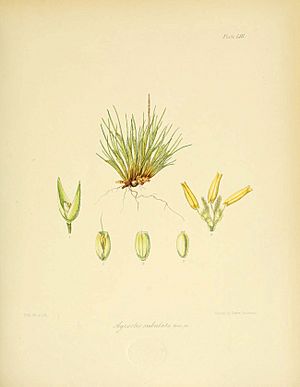Agrostis subulata facts for kids
Quick facts for kids Agrostis subulata |
|
|---|---|
 |
|
| Plate LIII (artist Fitch) | |
| Conservation status | |
|
Invalid status (NZ TCS)
|
|
| Scientific classification | |
| Genus: |
Agrostis
|
| Species: |
subulata
|
Agrostis subulata is a special type of grass. It belongs to the Poaceae family, which is the family of all grasses. This particular grass grows only on two islands in New Zealand: Campbell Island and Antipodes Island.
What is Agrostis subulata?
Agrostis subulata is a perennial grass. This means it lives for more than two years. It grows in thick clumps, forming dense tufts. Its leaves are a dull blue-green color and stand up straight. These leaves are taller than the plant's flower spikes, which are called inflorescences.
Where does it grow?
You can find Agrostis subulata in a few different places on the islands. It grows in areas called herbfields, which are open spaces with many small plants. It also lives in grasslands where another plant, Chionochloa antarctica, is common. Sometimes, you can spot it on rocky ledges that are covered with peat. Peat is a type of soil made from old, decayed plants.
How was it discovered?
The first time Agrostis subulata was officially described was in 1845. A scientist named Joseph Hooker wrote about it in his book, Flora Antarctica. This book described many plants found in the southern parts of the world.
Is it protected?
Yes, Agrostis subulata is considered "At Risk - Naturally Uncommon" in New Zealand. This means it is not found in many places naturally. Because it only grows on Campbell Island and Antipodes Island, its population is small. This special status was confirmed in 2009, 2012, and again in 2018. It helps scientists keep an eye on the grass and make sure it stays safe.

